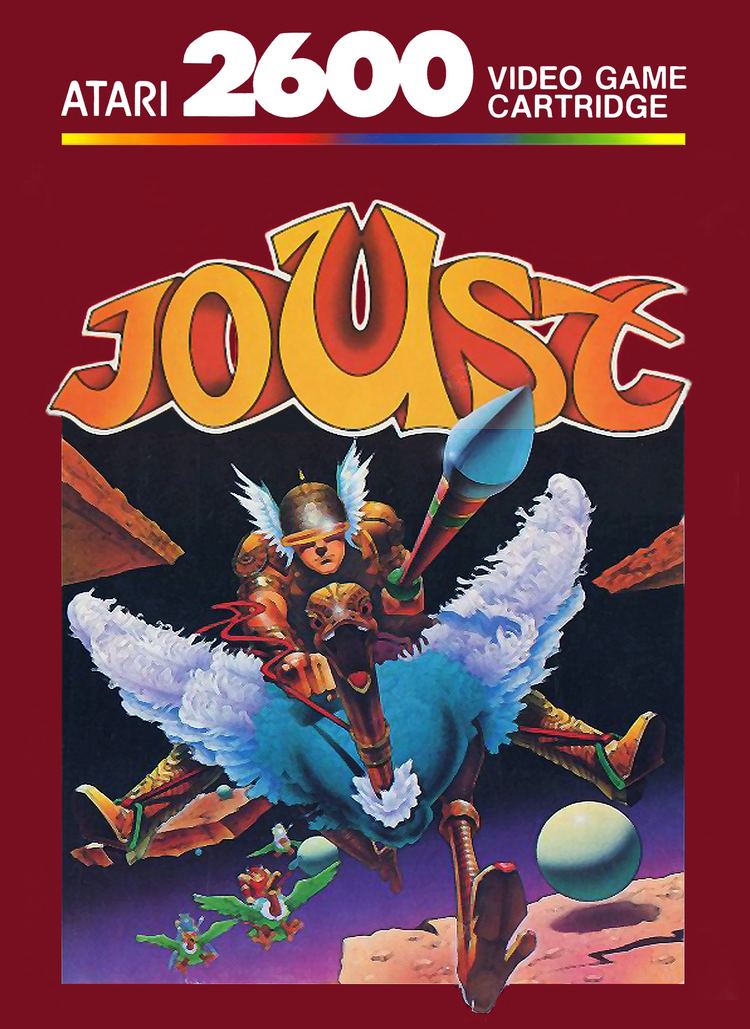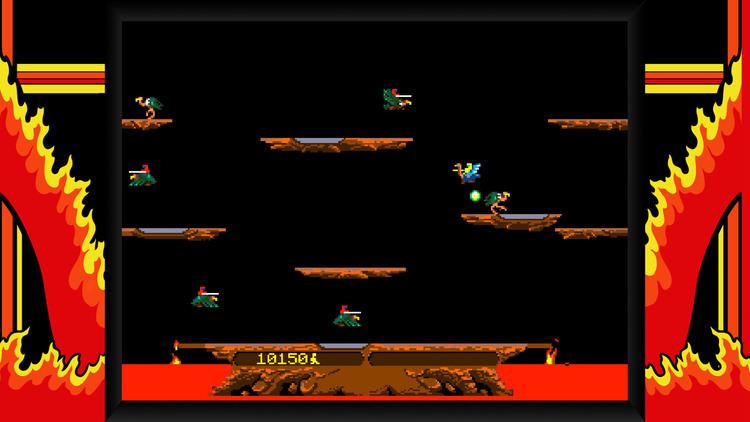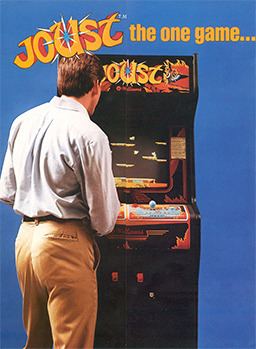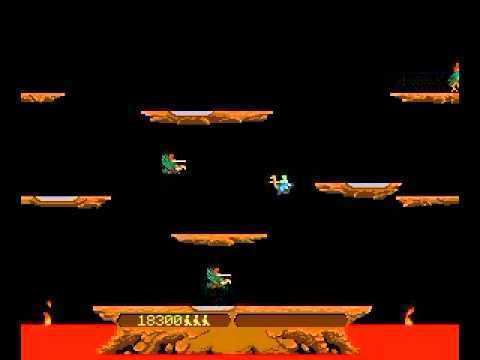Programmer(s) Bill Pfutzenreuter Initial release date 16 July 1982 | Cabinet Upright and table Genre Action game | |
 | ||
Artist(s) Jan HendricksPython Anghelo Composer(s) Tim MurphyJohn Kotlarik (sounds) Mode(s) Up to 2 players simultaneously Display HorizontalRaster, standard resolution (Used: 292 x 240)19 inch Publishers WMS Industries, Atari, Midway Games, Williams Entertainment Inc., HAL Laboratory, Atarisoft, HAL America Inc. Similar Atari games, Platform games | ||
Joust is an arcade game developed by Williams Electronics and released in 1982. While not the first game to feature two-player cooperative play, Joust was more successful than its predecessors and popularized the concept. The player uses a button and joystick to control a knight riding a flying ostrich. The object is to progress through levels by defeating groups of enemy knights riding buzzards.
Contents
- Gameplay
- Development
- Conception
- Creative and technical design
- Reception and legacy
- Sequels and remakes
- Influenced games
- Popular culture
- References

John Newcomer led the development team, which included Bill Pfutzenreuter, Jan Hendricks, Python Anghelo, Tim Murphy, and John Kotlarik. Newcomer aimed to create a flying game with cooperative two-player gameplay, but wanted to avoid a space theme, which was popular at the time.

The game was well received in arcades and by critics, who praised the gameplay, the mechanics of which influenced titles by other developers. Joust was followed by a sequel four years later, and was ported to numerous home and portable platforms.

Gameplay

The player controls a yellow knight riding a flying ostrich or stork, from a third-person perspective. Using the two-way directional joystick and the button for flapping the ostrich's wings, the player flies the knight amidst the floating rock platforms and above pools of lava; when maneuvering off the screen to either side, the player will continue its path reappearing from the opposite side. The rate at which the player repeatedly presses the button causes the ostrich to fly upward, hover, or slowly descend.

Players navigate the knight to collide with enemies. The elevation of an enemy in relation to the player's knight determines the outcome of the collision. If the protagonist is higher than the enemy, the villain is defeated and vice versa. A collision of equal elevations results in the two knights bouncing off each other. A defeated enemy will turn into an egg that falls toward the bottom of the screen, which a player can collect for points. An egg that sits on a platform long enough will hatch into a new knight; if the player does not pick him up, he will gain a new mount and must be defeated again.

The objective is to defeat groups of enemy knights riding buzzards that populate each level, referred to as a "wave". Upon completing a wave, a subsequent, more challenging wave begins. The game features three types of enemy knights—Bounder, Hunter, and Shadow Lord—that are worth different amounts of points. A pterodactyl appears after a predetermined time frame to hunt the heroes.
A second player, controlling a blue knight on a stork, can join the game. The two players can either cooperatively complete the waves or attack each other while competitively defeating enemies.
Development
Joust was developed by Williams Electronics, with John Newcomer as the lead designer. Programmer Bill Pfutzenrueter and artists Jan Hendricks and Python Anghelo assisted him. Tim Murphy and John Kotlarik handled the audio design. The game features amplified monaural sound and raster graphics on a 19 inch color CRT monitor. Like other Williams arcade games, Joust was programmed in assembly language. A pack of three AA batteries provide power to save the game's settings and high scores when the machine is unplugged from an electrical outlet. The cabinet artwork, by Anghelo, is stenciled on a wooden frame. Anghelo also designed artwork for promotional materials; one such flyer featured archaic English, which was also incorporated into the game's onscreen instructions and game-over message.
Conception
Following the success of the 1981 title Defender, Williams searched for new creative staff. Believing video games to be the future of entertainment, Newcomer left his job as a toy designer to work at the company who hired him to create game ideas as support for development staff. After a few days, he generated a list of ideas that included game ideas for The War of the Worlds and Joust, Newcomer's top two choices. Technical specifications dictated the selection; Newcomer's vision of The War of the Worlds was infeasible, but Joust could be accomplished with Williams' available hardware. A development team was formed, which decided to create the game using Defender's hardware.
Newcomer conceived Joust as a "flying game" with cooperative two-player gameplay; however, he did not wish to emulate the popular space theme of previous successful flying games like Asteroids and Defender. To that end, Newcomer made a list of things that could fly: machines, animals, and fictional characters. After evaluating the positive and negative of each idea, he chose birds, believing that they would have a wide appeal. Newcomer also felt that birds were a good fit as he was familiar with fantasy and science fiction media featuring birds. To further increase his understanding, Newcomer went to the library to study mythology. He felt that the primary protagonist should ride a majestic bird. The first choice was an eagle, but the lack of graceful land mobility dissuaded the designer. Instead, Newcomer chose an ostrich because he thought a flying ostrich was more believable than a running eagle. To differentiate between the first and second player characters, the developers picked a stork, believing the proportions were similar to an ostrich while the color difference would avoid confusion among players. Newcomer chose vultures as the main enemies, believing that they would be recognizably evil. Anghelo created concept art of the characters as guidance for further design.
Creative and technical design
The decision to use birds prompted Newcomer to deviate from the then standard eight-direction joystick. He implemented a "flapping" mechanism to allow players to control the character's ascent and descent. With the vertical direction controlled via the arcade cabinet's button, a two-way joystick was added to dictate horizontal direction. Though other Williams employees were concerned over the design, Newcomer believed that a direct control scheme for flight would strengthen the connection between the player and the character. The combat is devised to allow for higher levels of strategy than traditional shooting games. Because flying became an integral gameplay element, he chose to have characters collide as a means of combat. Newcomer felt that the characters' heights on the screen were the best way to determine a victor.
The developers created the game using 96K of memory, which limited the file size of individual graphics and sound effects they could use. The memory limits also prohibited Newcomer from creating more characters. The graphics were created at the pixel level and hand-animated. To animate the birds, Hendricks used Eadweard Muybridge's book Animals In Motion as a reference. Given the limited memory, she had to balance the number of frames to minimize file size, while maintaining realistic animation. Hendricks originally picked gray for the buzzards, but chose green instead to optimize the color palette as the developers had only 16 colors to create the visuals. Once the colors were decided for the character sprites, Newcomer finalized the look of the platforms. The hardware had limited audio capabilities, and sounds typically required larger amounts of memory than graphics. Working with these restrictions, Newcomer instructed Murphy and Kotlarik to focus on select sounds he deemed important to reinforcing gameplay. He reasoned that the audio would serve as conspicuous hints that players could use to adjust their strategy. Though Newcomer prioritized the wing flap, other sound effects like those related to the pterodactyl, collisions, and hatching eggs were considered important as well.
In designing the levels, Newcomer added platforms to the environment after the combat was devised. A static game world was chosen over a scrolling world to showcase visual textures applied to the platforms. The hardware could not easily display the textures while scrolling, and the team felt that displaying the whole environment would aid players. The last game world element was a lava pit and a hand reaching out of it to destroy characters too close to the bottom. Newcomer placed the platforms to optimize Pfutzenrueter's enemy artificial intelligence (AI), which factors attack patterns based partly on platform placements. The knight enemies were designed to exhibit progressively more aggressive behavior. Bounders fly around the environment randomly, occasionally reacting to the protagonist. Hunters seek the player's character in an effort to collide. Shadow Lords fly quickly and closer to the top of the screen. Pfutzenrueter designed them to fly higher when close to the protagonist to increase the Shadow Lord's chances of victory against the player. The pterodactyl was designed to attack idle players and be difficult to defeat. The only vulnerability was attacking the creature in its open mouth during a specific animation frame. Newcomer and Pfutzenrueter designed the pterodactyl to quickly fly upward at the last moment when approaching a player waiting at the edge of a platform. This was done to prevent an easy defeat of the enemy. When processing the graphics, the game gives priority to the player characters over the enemies. As a result, enemies begin to react more slowly when the number of on-screen sprites increases.
While playtesting the game, the team discovered an animation bug they described as a "belly flop". The flaw allows players to force the ostrich or stork sprite through an otherwise impassable small gap between two adjacent platforms of very close elevation. Because it provided an interesting method to perform a sneak attack on an opponent below the gap, the developers decided to keep the defect rather than fix it. Newcomer also attributed the inclusion to excessive playtesting that limited the time available to find a solution.
A second bug, which allows the pterodactyl to be easily defeated, was discovered after the game was first distributed. Newcomer designed the game and its AI with each sprite's dimension in mind. A day before the game was finished, however, the pterodactyl's sprite was altered to improve the appearance. The new sprite allowed the pterodactyl to be easily defeated an unending number of times. The player could sit on the center ledge, with a single enemy knight caught indefinitely in the hand of the "lava troll", and kill an unlimited number of pterodactyls simply by turning to face them as they entered the screen in a rapid, never-ending sequence. Using this flaw, the player could quickly accumulate a very high score and a large cache of lives, with no significant skill required. Upon learning of the flaw, Williams shipped a new ROM for the arcade cabinets to assuage distributors' complaints.
Reception and legacy
Given the different control scheme, Williams was concerned that the game would be unsuccessful. Though arcades were hesitant to purchase the game for the same reason, Joust sold well. Williams eventually shipped 26,000 units, and Electronic Games in 1983 described it as "tremendously popular". A cocktail table version was later released, engineered by Leo Ludzia. It differs from other cocktail games in that it features side-by-side seating rather than opposing sides. This setup allowed Williams to use the same ROM chip as in the upright cabinets. Though the upright cabinets are common, the cocktail version is a rare, sought-after game. Between 250 and 500 units were manufactured.
Author Steve Kent considered Joust one of the more memorable games of its time. Author David Ellis agreed, and stated that the game remains enjoyable to this day. In 2008, Guinness World Records listed it as the number sixty-nine arcade game in technical, creative, and cultural impact. A writer for Video Gaming Illustrated called Joust exotic and praised the animation as lifelike.
Kevin Bowen of GameSpy's Classic Gaming wrote that despite a concept he described as "incredibly stupid", Joust is an appealing game with good controls and competitive gameplay. Bowen further commented that the multiplayer aspect differentiated the game from others at the time. He described it as "one of the first really fun multiplayer games" and a precursor to the video game deathmatch.
Retro Gamer writer Mike Bevan praised the game's physics, calling them "beautifully realised", and described Joust as one of Williams' "most remarkable and well-loved titles". A Computer and Video Games writer called the game "weird and wonderful". Author John Sellers praised the competitive two-player gameplay, and attributed the game's appeal to the flapping mechanism. In 2004, Ellis described Joust as an example of innovative risk absent in the then-current video game industry.
In retrospect, Newcomer commended Williams' management for taking a risk on him and the game. The game has garnered praise from industry professionals as well. Jeff Peters of GearWorks Games lauded the gameplay, describing it as unique and intuitive. Fusion Learning Systems' Jeff Johannigman praised the flapping mechanism and Kim Pallister of Microsoft enjoyed the multi-player aspect.
Sequels and remakes
A Joust-themed pinball table was released in 1983, designed by Barry Oursler and Constantino Mitchell. The game includes artwork and themes from the arcade version. In addition to single player gameplay, it features competitive two-player gameplay with the players on opposing sides of the machine. Fewer than 500 machines were produced.
An arcade sequel, Joust 2: Survival of the Fittest, was released in 1986. It features similar gameplay with new elements on a vertical screen.
Joust was ported to the Nintendo Entertainment System—programmed by Satoru Iwata—and to several Atari platforms: the Atari 2600, Atari 5200, Atari 7800, and Atari Lynx consoles, as well as Atari 8-bit and Atari ST home computers. Entertainment Weekly called Joust one of the top ten games for the Atari 2600 in 2013. Apple II, Macintosh and MS-DOS versions were also released. Tiger Electronics released a small keychain version of Joust in 1998. A mobile phone version was released in 2005, but omitted the flapping control scheme. In 2000, a web-based version of Joust, along with nine other classic arcade games, was published on Shockwave.com.
Four years later, Midway Games also launched a website featuring the Shockwave versions. The game was included in several multi-platform compilations: the 1996 Williams Arcade's Greatest Hits, the 2000 Midway's Greatest Arcade Hits, and the 2003 Midway Arcade Treasures. Other compilation titles are the 1995 Arcade Classic 4 for the Game Boy and the 2005 Midway Arcade Treasures: Extended Play for the PlayStation Portable. Joust was released via digital distribution on GameTap, Xbox Live Arcade, and the PlayStation Network. In 2012, Joust was included in the compilation Midway Arcade Origins.
Other remakes were in development, but never released. Previously unreleased Atarisoft prototypes of Joust for the ColecoVision surfaced in 2001 at the Classic Gaming Expo in Las Vegas. An adaptation with three-dimensional (3D) graphics (and a port of the original Joust as a bonus) was in development for the Atari Jaguar CD. Titled Dactyl Joust, it was eventually canceled. Newcomer pitched an updated version of the arcade game for the Game Boy Advance to Midway Games. The company, however, did not sanction it. The prototype featured multi-directional scrolling, more detailed graphics based on 3D renders, and new gameplay mechanics.
Midway Games optioned Joust's movie rights to CP Productions in 2007. Michael Cerenzie and Christine Peters of CP Productions planned to expand on a game element for the film's premise. Cerenzie described the script by Marc Gottlieb as "Gladiator meets Mad Max", set 25 years in the future, and Peters commented that the action oriented film would appeal to a general audience. The movie was planned as a tent-pole movie, with a graphic novel by Steven-Elliot Altman as part of the media franchise's release. Midway Games also considered a video game adaptation of the film. Joust's expected release date was set in June 2008 and then later pushed back to 2009. The video game company, however, filed for Chapter 11 bankruptcy in 2009. Warner Bros. Interactive Entertainment purchased most of Midway's assets, including Joust, with the intent to develop movie adaptations.
Influenced games
Several titles by other developers feature gameplay that either copies or builds upon Joust's design. The 1983 Jetpac and Mario Bros. feature elements inspired by it, as does the 1984 Balloon Fight.
Popular culture
Joust has been parodied in popular culture. References appear in the Robot Chicken episode "Celebutard Mountain", the Code Monkeys episode "Just One of the Gamers", and the video games Mortal Kombat 3 and World of Warcraft: Cataclysm.
Joust features prominently in the book Ready Player One.
